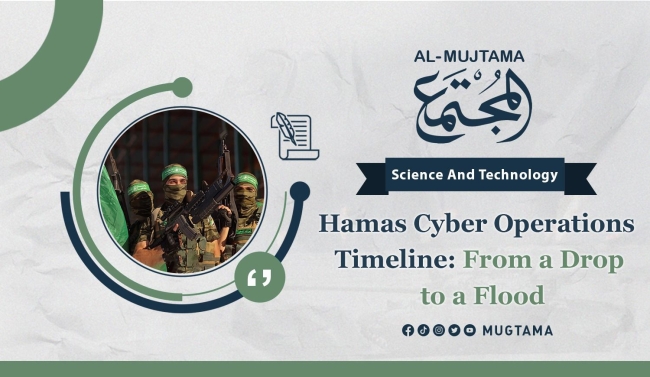Hamas Cyber Operations Timeline: From a Drop to a Flood Featured
The Murky World of Cyber Warfare
In the world of cyber warfare, things can get pretty confusing. Offensive cyber weapons are becoming more common, and it's hard to keep track of who's who in the battle. Criminals, states, activists, and others are all involved in this digital battlefield.
Hamas: The Interesting Cyber Warriors
The cyber warriors of Hamas, the Islamic Resistance Movement, have caught the attention of many. While some may not consider them strong or weak, they are definitely interesting, according to a senior officer in the IDFs Cyber Directorate.
How Did Hamas Develop Their Cyber Capabilities?
Let's take a look at how Hamas developed its cyber capabilities and what they have been up to.
The First Drop: "Spray and Hope"
In 2002, Hamas made its first known cyber attack against Israel. They hacked Israeli army reconnaissance drones and obtained footage recorded by these drones. At that time, their cyber operations were limited to phishing attacks, where they sent malicious spy files to random email accounts, hoping someone would open them. This tactic was known as "Spray and Pray."
The Drops Are Gathering: De Dos is the First Tactic
In 2012, during Operation "Cast Lead," Hamas attacked Israeli websites, including the Home Front Command and the Israeli army spokesman's website. They declared that electronic attacks were an integral part of their war against Israel.
In 2013, a group called "Izz al-Din al-Qassam Cyber Hackers" carried out a DDOS attack on the American Express website. Unlike traditional DDOS attacks, they used a programming language that allowed them to control a network of servers and carry out a more powerful attack.
In the summer of 2014, during the Israeli "Operation Protective Edge," Hamas increased its attempts to attack civilian and military sites in Israel. They even hacked soldiers through the WhatsApp application, gaining access to their phones and opening dating applications without their knowledge.
Floods of Love from Hamas Sweep Away Israeli Soldiers
In January 2017, it was revealed that Hamas had hacked dozens of phones belonging to Israeli soldiers and officers. They also hacked hundreds of military-related groups on Facebook, gaining access to private information.
In July 2018, Hamas launched a sophisticated cyber attack using fake profiles of women on social media networks. They aimed to control soldiers' mobile phones and computers. Through this attack, they were able to control microphones and cameras without the owners' knowledge.
Hamas also created a Facebook group and an Android application related to the 2018 FIFA World Cup to lure Israeli fans. By downloading the application, Israeli users unknowingly gave Hamas access to their phone data.
In August 2018, Hamas planted spyware on Israeli mobile phones through an application that mimicked the Red Alert app. This allowed them to gather information from unsuspecting users.
As you can see, Hamas has come a long way in developing its cyber capabilities. Their tactics have evolved over time, and they continue to pose a threat in the digital battlefield.
How Hamas Carries Out Cyber Attacks
Hamas has found a sneaky way to carry out cyber-attacks. They create fake profiles on social media platforms like Facebook and Twitter. These profiles trick people into downloading an application. Once the app is on their phones, Hamas gains control over them. They can then monitor and manipulate the phones from a distance. It's like having a spy in your pocket!
Timing is Everything
What's really interesting is that Hamas times their cyber-attacks to match their physical attacks. For example, when they launched hundreds of rockets at Israel, they also launched a major social media campaign. They created fake accounts that looked like they were from Hebrew speakers, urging people to download their new app. It was a coordinated effort to cause chaos and confusion.
Hamas' First Target
Before we dive into how Hamas' cyber-attacks have been successful, let's talk about a big moment in 2019. This was the first time a sophisticated army publicly announced that they were targeting a group of cyber hackers. The Israeli military claimed to have attacked a building in Gaza, which they said was the headquarters of Hamas' cyber force. It was a significant move that showed just how seriously they were taking this new kind of warfare.
How Hamas' Cyber Attacks Worked
Now, let's explore how Hamas' cyber-attacks have been successful. There are a few factors that have contributed to their effectiveness:
- Targeting Young and Inexperienced Soldiers
In Israel, military service is compulsory, which means most soldiers are young and inexperienced. Hamas took advantage of this by targeting them through dating apps and hobbies like football. They would gather information about the soldiers, their workplaces, relatives, and even their subordinates. This helped them create detailed profiles on each person, giving them valuable knowledge.
- Gathering Information from social media
Once Hamas had collected information from social media platforms, they would use special applications to target their victims. These apps were tailored to exploit the vulnerabilities they had discovered. For example, if they found out a soldier was into football, they might create a football-related app. The goal was to track the soldiers' movements, especially in specific areas like military camps. This kind of secret information is hard to obtain through traditional spying methods.
- Drawing Maps and Making Plans
Hamas' cyber warriors would use certain applications to draw maps of the soldiers' movements. This helped them understand the layout of military camps and plan their attacks. They could then provide their fighters on the ground with these maps, giving them an advantage during physical confrontations.
- Surprising the World
What's really impressive is that Hamas, with their limited resources, managed to penetrate Israel's advanced cyber defenses. They were like guerrilla fighters in the world of the Internet, using their skills to outsmart a country known for its cyber capabilities. It was a surprising and bold move.
Thus Hamas has shown us a new kind of threat - cyber-attacks. They have used fake profiles and sneaky apps to gain control over their enemies' phones. By targeting young soldiers and gathering information from social media, they were able to carry out successful attacks.


